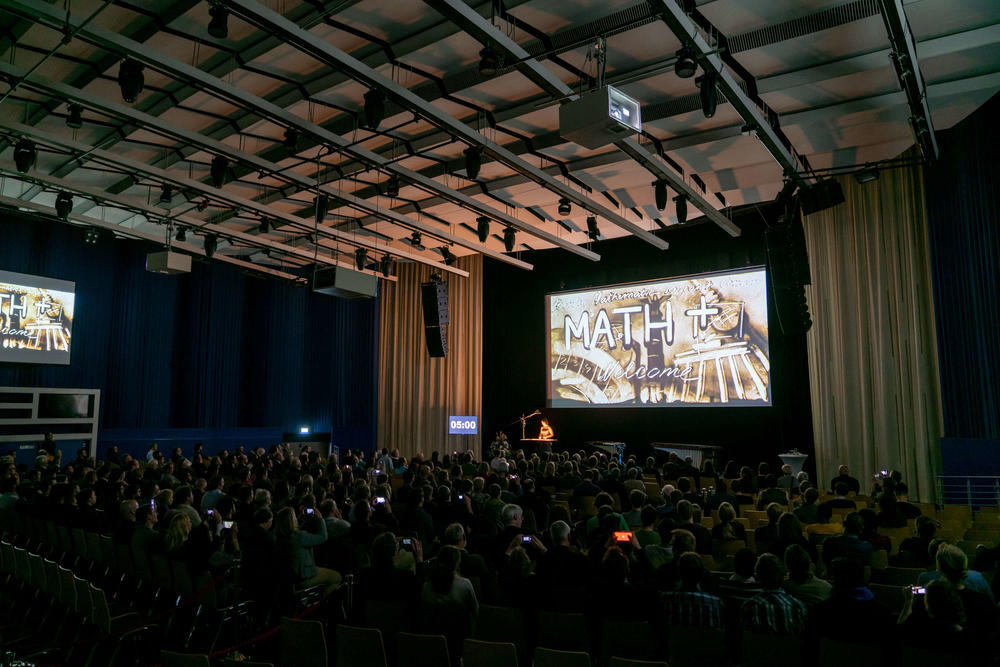Mathematics and More
The MATH+ Cluster of Excellence of Freie Universität Berlin, Humboldt-Universität zu Berlin, and Technische Universität Berlin has been established
May 27, 2019
Painting with sand: Artist Natalia Moro opened the ceremony with shifting silhouettes cast by sand.
Image Credit: Dominic Simon
Artist Natalia Moro generously scatters sand on the illuminated table. On a large screen, which shows projections of the sand’s silhouette, you can see her hand drawing lines and patterns with sparing, rapid movements. Detailed, intricate images of various Berlin scenes in attractive sepia tones gradually emerge before the astonished eyes of the audience. The quick brush of a hand, some more sand, and the face of Marlene Dietrich appears from between the subway arches of Berlin in the 1920s. With a few more hand movements, walls are built and torn down. In just minutes, the sand artist draws a quick walk through Berlin’s history and ends with “Welcome MATH+” displayed on the screen.
The spokespersons from MATH+ Cluster of Excellence: Christof Schütte, Martin Skutella, and Michael Hintermüller.
Image Credit: Dominic Simon
“Changing the world with mathematics: that is the motto of the Berlin Cluster of Excellence” Martin Skutella
This unusual artistic performance kicked off the opening ceremony of the MATH+ Cluster of Excellence in the Kosmos event center in Berlin, on May 14, 2019. Around 300 guests, researchers, students, and interested parties came together to celebrate the joint undertaking of the universities Freie Universität Berlin, Humboldt-Universität zu Berlin, and Technische Universität Berlin, which support the collaborative research project. It also receives support from the Weierstrass Institute for Applied Analysis and Stochastics (WIAS) and the Zuse Institute Berlin (ZIB). The Cluster’s spokesperson, Professor Martin Skutella of Technische Universität Berlin, announced in his welcoming address: “Changing the world with mathematics: that is the motto of the Berlin Cluster of Excellence.
The focus is on three core objectives: we want to advance mathematics as a science, develop truly innovative fields of application, and, above all, open up new territories of mathematical thinking.” The cluster unites the three Berlin universities and will build on the success of the Berlin research center Matheon and the Berlin Mathematical School (BMS).
Mathematics professor Günter M. Ziegler played a pivotal role in shaping the MATH+ proposal before he took the office of president of Freie Universität.
Image Credit: Dominic Simon
Approximately 300 people came to the opening ceremony for the Cluster of Excellence.
Image Credit: Dominic Simon
“If you want to go fast – go alone. If you want to go far – go together.” With this African proverb, which emphasizes the importance of collective action in achieving goals, mathematics professor Günter M. Ziegler, president of Freie Universität Berlin and keynote speaker of the event, signaled the project’s official launch. Before taking the executive position in university management, Günter M. Ziegler played an instrumental role in shaping the MATH+ proposal.
What does math have to do with the position of a football club in the German national league tables?
In an entertaining way, representatives of MATH+ demonstrated to the guests which topics the cluster will address. Five-minute “science slams” dealt with questions such as: What does math have to do with the position of a football club in the German national league tables? What do mathematicians have to do with spies? How quickly do rumors on social media spread? And even: How many neurons does the largest deep learning network contain? The answer: 16 million, about the same as the amount of neurons in a frog’s brain. The celebration was rounded off by musical performances on various percussion instruments by Lukas Böhm, Professor of Percussion at Hochschule für Musik und Tanz Köln.
The audience had a good time watching the science slam presenters and listening to a percussion interlude.
Image Credit: Dominic Simon
“We are looking forward to starting work on exciting mathematical topics of the future.” Martin Skutella
MATH+ aims to cover a research spectrum that ranges from pure mathematical abstraction to the solving of problems originating from the diverse worlds of technology, life science, sociology, and the humanities. The German Research Foundation (DFG) is funding the cluster with around six million euros per year, for the next seven years. Fifty-two research projects are currently being funded.
An extension for a further seven years is possible after a positive evaluation. During this time, MATH+ intends to establish a Berlin research center for application-oriented fundamental research in mathematics. “We are looking forward to working together with colleagues from various disciplines on exciting mathematical topics of the future,” said Martin Skutella.





